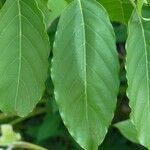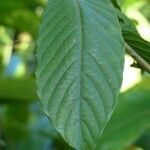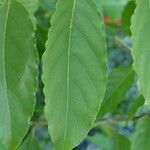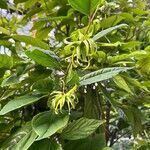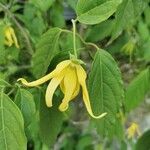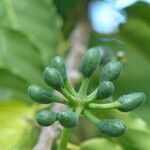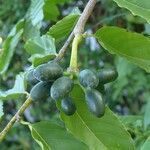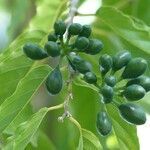Tree to 30 m high. Shoots pubescent with pale brown hairs; branchlets glabrescent. Leaves: petiole 1–1.7 (–2) cm long; lamina ovate, sometimes oblong, 8–22 cm long, 3.5–9 cm wide, rounded, truncate or obtuse, and slightly asymmetrical at base, acuminate or acute at apex, glabrescent; secondary veins 8–11 pairs. Cymes of few to c. 20 flowers. Flowers very fragrant. Pedicel 2.5–5 cm long; bracts narrowly ovate, 1.5–3 mm long. Sepals broadly ovate, 4–6 mm long, c. 5 mm wide, tomentellous; margins recurved. Petals 6, linear, c. 50–90 mm long, flat, tomentellous near base, elsewhere puberulous, pale greenish yellow. Outer petals mostly 60–90 mm long, 4–7 mm wide; inner petals slightly smaller. Stamens c. 130–170, 1.8–3 mm long, anther connective acute and projecting above and covering the anthers. Carpels c. 10–15; ovary nearly glabrous; ovules 10–14; stigma puberulous. Apocarps ovoid or subglobose, 1.5–2.5 cm long, 1–1.8 cm wide, black or green-black; stipe 1–2 cm long. Seeds 2–15, irregularly discoid, rugulose, pitted, brown.
Tree 6–18(–33) m. tall, with pale grey bark; young twigs minutely pubescent, later glabrous, dark-coloured and striate.. Leaf-blades ovate-oblong or elliptic-oblong, 10–21 cm. long, 4–10 cm. wide, often obliquely acuminate at the apex, broadly cuneate, rounded or truncate at the base, somewhat pubescent on the midrib and nerves; venation prominent.. Flowers drooping in 2–6-flowered racemes, very sweetly scented.. Petals green at first, then pale yellow, with a purple-brown spot at the base inside, linear-lanceolate, (2.5–)5–7.5(–8.7) cm. long, 5–7(–14) mm. wide, minutely pubescent.. Monocarps 10–16, ellipsoid or oblong-obovoid, 1.5–2.3 cm. long, glabrous.. Seeds pale brown, oblong-elliptic in outline, flattened, 9 mm. long, 6 mm. wide, 2.5 mm. thick, with rugose or pitted faces.. Fig. 15, p. 65.
An evergreen tree. It grows to 25 m tall and spreads to 5 m wide. The stem is erect and the branches are weeping. The leaves are alternate and simple. They are 20 cm long and with wavy edges. They are oval and tapering. The flowers are bright green. They are 7.5 cm long with twisted, drooping, narrow petals. They have a strong smell. Flowers are on short stalks and grow from old wood. The flowers occur in clusters in the axils of leaves. The fruit is made up of 10-12 seed buds and they are black.
